Uncategorized
Small Equipment Shipping The Essentials You Need to Know
Small Equipment Shipping The Essentials You Need to Know

Small Equipment Shipping The Essentials You Need to Know
Small equipment shipping can be a tricky business. Whether you’re a business owner, an e-commerce mogul, or just someone trying to send a delicate piece of machinery, there’s a lot that can go wrong. But don’t fret! This guide will break down everything you need to know to make your small equipment shipping experience smooth and hassle-free.
Understanding the Basics of Small Equipment Shipping
Shipping small equipment isn’t just about sticking a label on a box and hoping for the best. It’s an intricate process that involves selecting the right carrier, packing properly, and ensuring safe transit.Why Small Equipment Shipping Matters
Small equipment shipments are often overlooked, but they play a crucial role in various industries—whether it’s construction tools, electronics, or specialized gadgets. Getting the right equipment to the right place, safely and efficiently, can make all the difference in maintaining operations.- Fast turnaround times
- Preventing damages
- Cost-efficiency
Key Considerations for Shipping Small Equipment
Before diving into the logistics, let’s break down the key elements that you need to take into account when planning your small equipment shipping.1. Choose the Right Carrier
The carrier you choose can drastically impact the delivery speed and condition of your shipment. Some options include:- UPS: Reliable, with options for fast delivery and tracking.
- FedEx: Great for international shipping, offering a range of services.
- USPS: Cost-effective for smaller, lightweight equipment.
2. Proper Packaging Is Key
Don’t just throw your small equipment into a box and call it a day. Proper packaging is crucial to avoid damage during transit. Follow these tips:- Use sturdy boxes with ample padding.
- Cushion fragile parts with bubble wrap or foam.
- Seal the box securely with strong tape to prevent it from opening.
“Packaging isn’t just about keeping items safe; it’s about ensuring your shipment reaches its destination in one piece, regardless of how bumpy the ride may be.” – Shipping Expert
3. Track Your Shipment
Tracking your shipment allows you to monitor its progress and get ahead of any potential issues. Make sure your carrier offers a detailed tracking system, and always check in with your shipment’s status.4. Label Everything Clearly
Ensure that the labels are visible and easy to read. Include the recipient’s full address, your return address, and any special instructions on handling. This can be especially important for equipment that needs to be treated with care.5. Insurance Is a Must
For valuable equipment, it’s smart to invest in insurance. This can help cover the cost of lost or damaged items during transit.Common Mistakes in Small Equipment Shipping (and How to Avoid Them)
Even experienced shippers make mistakes. Here are some common errors—and how you can sidestep them:Mistake 1: Incorrect Labeling
Wrong labels are a huge issue. They can cause delays, confusion, or worse, lost shipments. Always double-check your labels and ensure all relevant details are clear and accurate.Mistake 2: Improper Packaging
You might be tempted to cut costs with flimsy packing materials, but this can end up costing more in the long run. Invest in proper packaging to prevent any damage.Mistake 3: Neglecting to Insure Your Shipment
If you’re shipping something valuable, don’t risk it. Always get insurance and keep all relevant documentation in case of a claim.“It’s always better to over-prepare when shipping small equipment—because when things go wrong, it’s much harder to fix than if you had planned ahead.” – Logistics Specialist
Tips for International Small Equipment Shipping
Shipping small equipment across borders comes with its own set of challenges. Here are a few tips to keep in mind:- Know the customs regulations: Different countries have different rules when it comes to shipping. Make sure you understand what is allowed and the necessary paperwork.
- Choose a carrier with international reach: Not all carriers are created equal when it comes to global shipping, so opt for one with extensive international experience.
Generating... Please wait seconds
URL Copied



